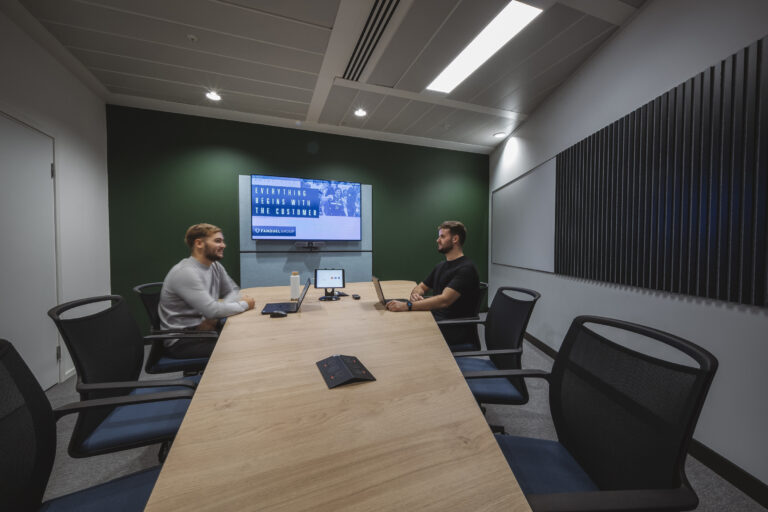
Striking The Balance – The optimal mix between home and office working
Date
3 January 2023
Read length
4 min
Developing an effective workplace experience is a balancing act. Trying to get back to some sort of ‘normality’ post pandemic is presenting a significant challenge to many organisations, and right now, many workplaces are out of equilibrium; this may not be a bad thing as it allows organisations to adapt by changing emphasis as required.
In the new world of hybrid working, the biggest question facing employers and employees alike is what is the optimal mix between home and office working?
The last few years have been a celebration of home working for employees – but while many employers embraced it during the height of the pandemic, they now yearn for their people to return to the workplace.
Finding the right balance is the key – not just to ensure employees feel happy, valued and trusted but for employers to keep their employees close, facilitate collaboration, build the bonds that bind and offer a dose of brand.
But in order to strike the right balance between home and office, we must first ask, why has homeworking become so popular?
A survey from the Office of National Statistics said that 78% of those working from home said that it gave them better work life balance and that’s almost certainly one of the biggest national, if not global work outcomes from the pandemic. When we accept that work is an act, not a place, home becomes a very viable work environment. It has the potential to boost employees’ lives in so many ways especially in relation to when they work. It removes the time and cost of commuting, frees up time for childcare and other family responsibilities and allows employees to build time for health and wellbeing into their day.
But even with these benefits, employees do still recognise the value of the workplace and 83% [1] say they want a hybrid working model. Our annual research of more than 6000 employees (you can see the full report here) reveals that for employees, two days a week in the office is ideal. Tuesdays and Wednesdays are their preferred days, although flexibility to choose these days as they see fit is high on their wish list too.
The four main reasons people want to visit the office are to connect with colleagues, to socialise with others, to collaborate and crucially, to provide some separation between home and work. This of course alludes to the fact that head-down, concentrated work is often more suited to home working – it does not need to take place in the office. Interestingly our data shows that 55% of the day is spent on these focused head-down tasks, but that the remaining 44% is spent on collaboration and communication. When you consider this is almost a 50/50 split – it’s clear that the workplace still has tremendous value to offer.
So, how do you get the optimal mix?
The answer to this question lies in a greater understanding of why the employee experience matters so much. This is not the same as employee engagement – this is giving consideration to the holistic needs and therefore experiences of employees, all the way from recruitment through to onboarding, training and development, ongoing support and departure.
Consequently – there are four things to remember when trying to get the optimal mix between home and office working. They are:
- Offer the experiences that home working can’t – We know employees want to collaborate and socialise in person – the two things that aren’t possible remotely – so workspaces should actively encourage and facilitate those types of encounters and experiences.
- Get the basics right – Noise, temperature, fresh air, lighting levels, cleanliness and tidiness, healthy nutrition, wellbeing, nice clean toilets, plants and personal technology set-up are among the things we can control in our home environment – but we have to relinquish that at work. Unless these elements are as good as or better than at home, there will be a perceived reduction in environmental working quality, and a potential reluctance to return to the office. Get the basics right.
- Recognise employees want control and personalisation. We expect personalised experiences in our non-working lives (internet, social channels, digital entertainment etc) so we’ve come to expect them at work too. Some of this can be addressed by getting the basics right (point 2) but it also requires offering choice so that employees can choose the right workspace or setting for them – be that to support a specific task or simply how they feel.
- Actively address the issues – If you know your workplace isn’t delivering in certain areas make changes. To avoid the issue or disregard its importance will only make it easier for employees to leave. 52% of employees said that flexible working policies will affect their decision to stay at an organisation[2].
To find out more about how to achieve balance in the post-pandemic hybrid workplace and the office interior design and behavioural trends we identified in our annual Insight report – download your copy here.
[1] Data from Accenture
[2] Gartner
See how we could help with your new office interior design or office design and build project here
Get in touch
We love nothing better than talking all things workplace and design – got a question, potential project or just need some guidance?
Drop us a note…





